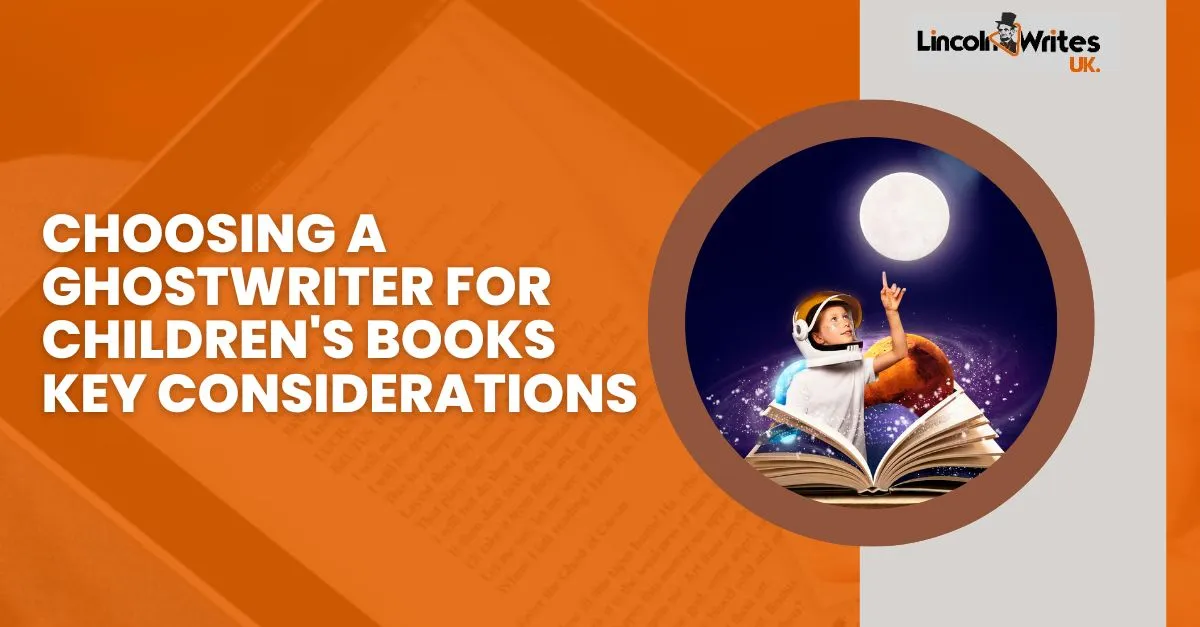You’ve got a brilliant idea for a children’s book, maybe it’s been living in your head for years, or maybe it hit you during your toddler’s fifth reading of The Gruffalo. Either way, you’re ready to bring your story to life. But remember, writing for a children’s book is a double edged sword. Either you’re a great storyteller, or you can’t quite catch their attention, there’s no one-way to it.
But the good news is there’s a work around for that. And that’s where we introduce you to the wonderful world of children’s book ghostwriters.
Working with a professional ghostwriter gives you access to not only great storytelling but also a deep understanding of child psychology, age-appropriate language, and industry trends. But hiring the right one? That takes thought.
Today’s blog is all about choosing the best children’s book ghostwriter, how to avoid common pitfalls, and why pairing your story with the right expert is one of the smartest moves you can make.
Why Hire a Children’s Book Ghostwriter?
Let’s start with the basics: why work with a ghostwriter in the first place?
Maybe you’re a parent with a magical idea but no writing experience. Maybe you’re a teacher or therapist wanting to create educational materials for kids. Or maybe you’re launching a brand and want a charming children’s book to support your business.
A children’s book ghostwriter can take your concept and turn it into a polished, engaging, age-appropriate manuscript. They understand:
- How children absorb and interpret language
- Narrative pacing and repetition
- Emotional arcs suitable for early development stages
- How illustrations work with text to tell the full story
This isn’t about outsourcing, it’s about collaboration. In fact, the process often sits right in the middle of collaborative writing vs ghostwriting, depending on how hands-on you want to be.
Key Traits to Look For in a Children’s Book Ghostwriter
If you’re thinking about working with a children’s book ghostwriter, you need to know that not every ghostwriter will work. There are a certain characteristics you need to make certain of first before partnering up with one. Here is what you need to make sure of:
1. Experience With Age-Appropriate Language
Writing for a 3-year-old is nothing like writing for a 7-year-old. The vocabulary, sentence structure, rhythm, and even the types of humour differ drastically.
Look for ghostwriters who specify which age ranges they write for. Ask for writing samples or request to see books they’ve ghostwritten before (confidentiality allowing).
This attention to detail is as critical in children’s writing as it is in technical ghostwriting. It’s just applied differently.
2. Understanding of the Visual Narrative
Children’s books are visual. The story doesn’t stop at the words. It continues in the illustrations.
Even if the ghostwriter isn’t responsible for art direction, they must understand how text and visuals work together. This includes:
- Leaving space for images
- Suggesting illustration prompts
- Coordinating page turns with story tension
If you’re planning to prepare a manuscript for ebook release or print, that structure becomes essential to layout and pacing.
3. Imaginative Storytelling and Structure
Kids love stories that surprise, delight, and teach them something without being preachy. A great children’s book ghostwriter will know how to:
- Craft memorable characters
- Build gentle arcs of conflict and resolution
- Use repetition to reinforce learning
- Integrate rhyming or rhythm (only when appropriate)
And if you’re planning a follow-up book, or an entire educational collection, look for someone with ghostwritten series planning experience. It’ll help you keep tone and narrative consistent across titles.
4. Editing and Proofreading Skills
Children’s books may be short, but they need to be tight. There’s no room for fluff, clunky phrases, or (worse) errors.
Your ghostwriter should either provide or work closely with a qualified editor, someone who understands the importance of proofreading, especially in published material for young readers.
This is also where understanding the difference between proofreading ebooks vs print matters. A well-formatted ebook may behave differently on various devices, and you need a team that catches layout oddities or formatting issues before launch.
Whether human or automated, human vs AI proofreading always favours a real editor, especially in stories requiring nuance, tone, and warmth.
5. Contract Clarity and Publishing Experience
A professional ghostwriter will always work under a contract. It should outline:
- Payment terms
- Delivery deadlines
- Rights ownership
- Revisions included
The ghostwriting contract is your safety net, protecting your vision, your timeline, and your intellectual property. Be wary of any freelancer who skips this step.
If you’re new to publishing, your ghostwriter (or their team) should also guide you on the next steps, like:
- eBook metadata optimisation
- How to evaluate ebook publishing contract offers
- Spotting ebook publishing scams
- Connecting with the top ebook publishers in the UK
You want someone who’s more than a writer. You want a trusted partner.
Red Flags to Avoid
Not every ghostwriter is a good fit. Watch out for:
- Generic writing samples that don’t show age-specific skills
- Lack of knowledge about publishing options
- Unclear pricing or rights discussion
- Poor grammar (yes, we’ve seen it) and common grammar mistakes in proposals
- No discussion of authenticity in ghostwriting, they should want to capture your voice and purpose
And if someone promises to “get your book published for a fee,” make sure you’re not being led into a vanity trap. Always verify credibility, testimonials, and contracts.
How to Work With a Children’s Book Ghostwriter
Here’s what a typical collaboration might look like:
- Discovery Call: You talk through your book idea, goals, audience, and expectations.
- Concept Development: The ghostwriter drafts an outline or sample pages.
- Writing Phase: The full draft is completed with your feedback at key milestones.
- Editing & Proofreading: The text is polished by an editor, ideally someone who can choose the right proofreader for children’s literature.
- Final Delivery: You receive a ready-to-format manuscript that’s suitable for illustration, ebook layout, or print.
This is also the point where you might start working with illustrators. A good ghostwriter may have recommendations or even partnerships in place, saving you time and stress.
Final Note
Hiring a children’s book ghostwriter is one of the smartest investments you can make if you want your story to resonate, teach, and entertain young readers. But it’s not just about finding a great writer. It’s about finding someone who understands children, illustration, structure, and most importantly, you.
At Lincoln Writes UK, our ghostwriting services are built around capturing your vision, writing with care, and guiding you through every step of the publishing process. Whether you’re creating a standalone tale or a ghostwritten series, we’re here to help you craft stories that kids (and parents) will cherish for years to come.
Need help outlining your first children’s book idea or navigating contracts and formatting? Let us know, we’d love to support your storytelling journey.


